Research Progress in Semiconductor Materials with Application in the Photocatalytic Reduction of CO2
Abstract
:1. Introduction
2. Semiconductor Materials for the Photocatalytic Reduction of CO2
2.1. TiO2 Photocatalyst
2.2. Co/Ni-Based Catalysts
2.3. Metal Halide Perovskites (MHPs)
2.4. Metal-Organic Frameworks (MOFs)
2.5. Other Semiconductor Photocatalysts
3. Principle of the Photocatalytic Reduction of CO2
3.1. Process of the Photocatalytic Reduction of CO2
3.2. Types of Photocatalytic CO2 Reduction
3.3. Reaction Conditions of Photocatalytic CO2 Reduction
4. Conclusions and Perspectives
Author Contributions
Funding
Conflicts of Interest
References
- Varga, B.; Vida, G.; Varga-Laszlo, E.; Hoffmann, B.; Veisz, O. Combined Effect of Drought Stress and Elevated Atmospheric CO2 Concentration on the Yield Parameters and Water Use Properties of Winter Wheat (Triticum aestivum L.) Genotypes. J. Agron. Crop. Sci. 2017, 203, 192–205. [Google Scholar] [CrossRef]
- Li, X.; Yu, J.; Jaroniec, M.; Chen, X. Cocatalysts for Selective Photoreduction of CO2 into Solar Fuels. Chem. Rev. 2019, 119, 3962–4179. [Google Scholar] [CrossRef] [PubMed]
- Liddicoat, S.K.; Wiltshire, A.J.; Jones, C.D.; Arora, V.K.; Brovkin, V.; Cadule, P.; Hajima, T.; Lawrence, D.M.; Pongratz, J.; Schwinger, J.; et al. Compatible Fossil Fuel CO2 Emissions in the CMIP6 Earth System Models’ Historical and Shared Socioeconomic Pathway Experiments of the Twenty-First Century. J. Clim. 2021, 34, 2853–2875. [Google Scholar] [CrossRef]
- Yin, Y.; Bowman, K.; Bloom, A.A.; Worden, J. Detection of Fossil Fuel Emission Trends in the Presence of Natural Carbon Cycle Variability. Environ. Res. Lett. 2019, 14, 084050. [Google Scholar] [CrossRef]
- Vermeer, M.; Rahmstorf, S. Global Sea Level Linked to Global Temperature. Proc. Natl. Acad. Sci. USA 2009, 106, 21527–21532. [Google Scholar] [CrossRef] [PubMed] [Green Version]
- Chang, J.; Clay, D.E.; Clay, S.A.; Chintala, R.; Miller, J.M.; Schumacher, T. Biochar Reduced Nitrous Oxide and Carbon Dioxide Emissions from Soil with Different Water and Temperature Cycles. Agron. J. 2016, 108, 2214–2221. [Google Scholar] [CrossRef] [Green Version]
- Wang, Y.; Han, P.; Lv, X.; Zhang, L.; Zheng, G. Defect and Interface Engineering for Aqueous Electrocatalytic CO2 Reduction. Joule 2018, 2, 2551–2582. [Google Scholar] [CrossRef] [Green Version]
- Xie, H.; Wang, Y.; He, Y.; Gou, M.; Liu, T.; Wang, J.; Tang, L.; Jiang, W.; Zhang, R.; Xie, L.; et al. Generation of Electricity from CO2 Mineralization: Principle and Realization. Sci. China Technol. Sci. 2014, 57, 2335–2343. [Google Scholar] [CrossRef]
- Cao, S.; Shen, B.; Tong, T.; Fu, J.; Yu, J. 2D/2D Heterojunction of Ultrathin Mxene/Bi2WO6 Nanosheets for Improved Photocatalytic CO2 Reduction. Adv. Funct. Mater. 2018, 28, 1800136. [Google Scholar] [CrossRef]
- Xia, P.; Zhu, B.; Yu, J.; Cao, S.; Jaroniec, M. Ultra-Thin Nanosheet Assemblies of Graphitic Carbon Nitride for Enhanced Photocatalytic CO2 Reduction. J. Mater. Chem. A 2017, 5, 3230–3238. [Google Scholar] [CrossRef]
- Low, J.; Cheng, B.; Yu, J. Surface Modification and Enhanced Photocatalytic CO2 Reduction Performance of TiO2: A Review. Appl. Surf. Sci. 2017, 392, 658–686. [Google Scholar] [CrossRef]
- Habisreutinger, S.N.; Schmidt-Mende, L.; Stolarczyk, J.K. Photocatalytic Reduction of CO2 on TiO2 and Other Semiconductors. Angew. Chem. Int. Ed. 2013, 52, 7372–7408. [Google Scholar] [CrossRef] [PubMed]
- Liu, L.; Zhao, H.; Andino, J.M.; Li, Y. Photocatalytic CO2 Reduction with H2O on TiO2 Nanocrystals: Comparison of Anatase, Rutile, and Brookite Polymorphs and Exploration of Surface Chemistry. ACS Catal. 2012, 2, 1817–1828. [Google Scholar] [CrossRef]
- Fujishima, A.; Honda, K. Electrochemical Photolysis of Water at a Semiconductor Electrode. Nature 1972, 238, 37–38. [Google Scholar] [CrossRef] [PubMed]
- Shehzad, N.; Tahir, M.; Johari, K.; Murugesan, T.; Hussain, M. Improved Interfacial Bonding of Graphene-TiO2 with Enhanced Photocatalytic Reduction of CO2 into Solar Fuel. J. Environ. Chem. Eng. 2018, 6, 6947–6957. [Google Scholar] [CrossRef]
- Wei, L.; Yu, C.; Zhang, Q.; Liu, H.; Wang, Y. TiO2-Based Heterojunction Photocatalysts for Photocatalytic Reduction of CO2 into Solar Fuels. J. Mater. Chem. A 2018, 6, 22411–22436. [Google Scholar] [CrossRef]
- Cai, J.; Shen, F.; Shi, Z.; Lai, Y.; Sun, J. Nanostructured TiO2 for Light-Driven CO2 Conversion into Solar Fuels. APL Mater. 2020, 8, 040914. [Google Scholar] [CrossRef] [Green Version]
- Han, B.; Ou, X.; Deng, Z.; Song, Y.; Tian, C.; Deng, H.; Xu, Y.-J.; Lin, Z. Nickel Metal-Organic Framework Monolayers for Photoreduction of Diluted CO2: Metal-Node-Dependent Activity and Selectivity. Angew. Chem. Int. Ed. 2018, 57, 16811–16815. [Google Scholar] [CrossRef]
- Song, K.; Qiu, X.; Han, B.; Liang, S.; Lin, Z. Efficient Upcycling Electroplating Sludge and Waste Pet into Ni-MOF Nanocrystals for the Effective Photoreduction of CO2. Environ. Sci.-Nano. 2021, 8, 390–398. [Google Scholar] [CrossRef]
- Wang, H.-N.; Sun, H.-X.; Fu, Y.-M.; Meng, X.; Zou, Y.-H.; He, Y.-O.; Yang, R.-G. Varied Proton Conductivity and Photoreduction CO2 Performance of Isostructural Heterometallic Cluster Based Metal-Organic Frameworks. Inorg. Chem. Front. 2021, 8, 4062–4071. [Google Scholar] [CrossRef]
- Yu, X.; Ordomsky, V.V.; Khodakov, A.Y. Selective Deposition of Cobalt and Copper Oxides on BiVO4 Facets for Enhancement of CO2 Photocatalytic Reduction to Hydrocarbons. ChemCatChem 2020, 12, 740–749. [Google Scholar] [CrossRef]
- Wang, X.; Wang, Y.; Gao, M.; Shen, J.; Pu, X.; Zhang, Z.; Lin, H.; Wang, X. BiVO4/Bi4Ti3O12 Heterojunction Enabling Efficient Photocatalytic Reduction of CO2 with H2O to CH3OH and CO. Appl. Catal. B Environ. 2020, 270, 118876. [Google Scholar] [CrossRef]
- Li, X.; Wei, D.; Ye, L.; Li, Z. Fabrication of Cu2O-RGO/BiVO4 Nanocomposite for Simultaneous Photocatalytic CO2 Reduction and Benzyl Alcohol Oxidation under Visible Light. Inorg. Chem. Commun. 2019, 104, 171–177. [Google Scholar] [CrossRef]
- Que, M.; Zhao, Y.; Yang, Y.; Pan, L.; Lei, W.; Cai, W.; Yuan, H.; Chen, J.; Zhu, G. Anchoring of Formamidinium Lead Bromide Quantum Dots on Ti3C2 Nanosheets for Efficient Photocatalytic Reduction of CO2. ACS Appl. Mater. Interfaces 2021, 13, 6180–6187. [Google Scholar] [CrossRef] [PubMed]
- Ren, K.; Yue, S.; Li, C.; Fang, Z.; Gasem, K.A.M.; Leszczynski, J.; Qu, S.; Wang, Z.; Fan, M. Metal Halide Perovskites for Photocatalysis Applications. J. Mater. Chem. A 2022, 10, 407–429. [Google Scholar] [CrossRef]
- Park, S.; Choi, S.; Kim, S.; Nam, K.T. Metal Halide Perovskites for Solar Fuel Production and Photoreactions. J. Phys. Chem. Lett. 2021, 12, 8292–8301. [Google Scholar] [CrossRef]
- Wang, S.; Wang, L.; Huang, W. Bismuth-Based Photocatalysts for Solar Energy Conversion. J. Mater. Chem. A 2020, 8, 24307–24352. [Google Scholar] [CrossRef]
- Nosaka, Y.; Nosaka, A.Y. Generation and Detection of Reactive Oxygen Species in Photocatalysis. Chem. Rev. 2017, 117, 11302–11336. [Google Scholar] [CrossRef]
- Yang, Y.; Liu, J.; Liu, F.; Wu, D. Reaction Mechanism of CO2 Methanation over Rh/TiO2 Catalyst. Fuel 2020, 276, 118093. [Google Scholar] [CrossRef]
- Do, J.Y.; Kwak, B.S.; Park, S.-M.; Kang, M. Effective Carbon Dioxide Photoreduction over Metals (Fe-, Co-, Ni-, and Cu-) Incorporated TiO2/Basalt Fiber Films. Int. J. Photoenergy 2016, 2016, 5195138. [Google Scholar] [CrossRef] [Green Version]
- Yan, Z.-H.; Ma, B.; Li, S.-R.; Liu, J.; Chen, R.; Du, M.-H.; Jin, S.; Zhuang, G.-L.; Long, L.-S.; Kong, X.-J.; et al. Encapsulating a Ni(II) Molecular Catalyst in Photoactive Metal-Organic Framework for Highly Efficient Photoreduction of CO2. Sci. Bull. 2019, 64, 976–985. [Google Scholar] [CrossRef] [Green Version]
- Han, B.; Song, J.; Liang, S.; Chen, W.; Deng, H.; Ou, X.; Xu, Y.-J.; Lin, Z. Hierarchical NiCo2O4 Hollow Nanocages for Photoreduction of Diluted CO2: Adsorption and Active Sites Engineering. Appl. Catal. B Environ. 2020, 260, 118208. [Google Scholar] [CrossRef]
- Xu, S.; Carter, E.A. Theoretical Insights into Heterogeneous (Photo)Electrochemical CO2 Reduction. Chem. Rev. 2019, 119, 6631–6669. [Google Scholar] [CrossRef] [PubMed]
- Yang, H.; Teng, F.; Gu, W.; Liu, Z.; Zhao, Y.; Zhang, A.; Liu, Z.; Teng, Y. A Simple Post-Synthesis Conversion Approach to Zn(OH)F and the Effects of Fluorine and Hydroxyl on the Photodegradation Properties of Dye Wastewater. J. Hazard. Mater. 2017, 333, 250–258. [Google Scholar] [CrossRef] [PubMed] [Green Version]
- Zhang, Z.; Wang, L.; Liu, W.; Yan, Z.; Zhu, Y.; Zhou, S.; Guan, S. Photogenerated-Hole-Induced Rapid Elimination of Solid Tumors by the Supramolecular Porphyrin Photocatalyst. Natl. Sci. Rev. 2021, 8, 155. [Google Scholar] [CrossRef] [PubMed]
- Vu, N.-N.; Kaliaguine, S.; Do, T.-O. Critical Aspects and Recent Advances in Structural Engineering of Photocatalysts for Sunlight-Driven Photocatalytic Reduction of CO2 into Fuels. Adv. Funct. Mater. 2019, 29, 1901825. [Google Scholar] [CrossRef]
- Chen, C.; Ma, W.; Zhao, J. Semiconductor-Mediated Photodegradation of Pollutants under Visible-Light Irradiation. Chem. Soc. Rev. 2010, 39, 4206–4219. [Google Scholar] [CrossRef]
- Li, C.-J.; Xu, G.-R.; Zhang, B.; Gong, J.R. High Selectivity in Visible-Light-Driven Partial Photocatalytic Oxidation of Benzyl Alcohol into Benzaldehyde over Single-Crystalline Rutile TiO2 Nanorods. Appl. Catal. B Environ. 2012, 115, 201–208. [Google Scholar] [CrossRef]
- Lertthanaphol, N.; Pienutsa, N.; Chusri, K.; Sornsuchat, T.; Chanthara, P.; Seeharaj, P.; Kim-Lohsoontorn, P.; Srinives, S. One-Step Hydrothermal Synthesis of Precious Metal-Doped Titanium Dioxide-Graphene Oxide Composites for Photocatalytic Conversion of CO2 to Ethanol. ACS Omega 2021, 6, 35769–35779. [Google Scholar] [CrossRef]
- Xing, F.; Liu, Q.; Song, M.; Huang, C. Fluorine Modified Boron Carbon Nitride Semiconductors for Improved Photocatalytic CO2 Reduction under Visible Light. ChemCatChem 2018, 10, 5270–5279. [Google Scholar] [CrossRef]
- Ma, Z.; Li, P.; Ye, L.; Wang, L.; Xie, H.; Zhou, Y. Selectivity Reversal of Photocatalytic CO2 Reduction by Pt Loading. Catal. Sci. Technol. 2018, 8, 5129–5132. [Google Scholar] [CrossRef]
- Bowker, M.; Bahruji, H.; Kennedy, J.; Jones, W.; Hartley, G.; Morton, C. The Photocatalytic Window: Photo-Reforming of Organics and Water Splitting for Sustainable Hydrogen Production. Catal. Lett. 2015, 145, 214–219. [Google Scholar] [CrossRef] [Green Version]
- Inoue, T.; Fujishima, A.; Konishi, S.; Honda, K. Photoelectrocatalytic Reduction of Carbon Dioxide in Aqueous Suspensions of Semiconductor Powders. Nature 1979, 277, 637–638. [Google Scholar] [CrossRef]
- Moebs, J.; Gerhard, M.; Heine, J. (Hpy)2(Py)CuBi3I12, a Low Bandgap Metal Halide Photoconductor. Dalton Trans. 2020, 49, 14397–14400. [Google Scholar] [CrossRef] [PubMed]
- Park, B.-W.; Philippe, B.; Zhang, X.; Rensmo, H.; Boschloo, G.; Johansson, E.M.J. Bismuth Based Hybrid Perovskites A3Bi2I9 (A: Methylammonium or Cesium) for Solar Cell Application. Adv. Mater. 2015, 27, 6806–6813. [Google Scholar] [CrossRef] [PubMed]
- Xu, Q.; Zhang, L.; Cheng, B.; Fan, J.; Yu, J. S-Scheme Heterojunction Photocatalyst. Chem 2020, 6, 1543–1559. [Google Scholar] [CrossRef]
- Shen, Y.; Ren, F.; Liu, H. Progress in Research on Photocatalytic Performance of Doped-TiO2. Rare Met. Mater. Eng. 2006, 35, 1841–1844. [Google Scholar]
- Miodynska, M.; Mikolajczyk, A.; Bajorowicz, B.; Zwara, J.; Klimczuk, T.; Lisowski, W.; Trykowski, G.; Pinto, H.P.; Zaleska-Medynska, A. Urchin-Like TiO2 Structures Decorated with Lanthanide-Doped Bi2S3 Quantum Dots to Boost Hydrogen Photogeneration Performance. Appl. Catal. B Environ. 2020, 272, 118962. [Google Scholar] [CrossRef]
- Wang, J.; Shen, Y.; Liu, S.; Zhang, Y. Single 2D Mxene Precursor-Derived TiO2 Nanosheets with a Uniform Decoration of Amorphous Carbon for Enhancing Photocatalytic Water Splitting. Appl. Catal. B Environ. 2020, 270, 118885. [Google Scholar] [CrossRef]
- Li, F.; Xiao, X.; Zhao, C.; Liu, J.; Li, Q.; Guo, C.; Tian, C.; Zhang, L.; Hu, J.; Jiang, B. TiO2-on-C3N4 Double-Shell Microtubes: In-Situ Fabricated Heterostructures toward Enhanced Photocatalytic Hydrogen Evolution. J. Colloid Interface Sci. 2020, 572, 22–30. [Google Scholar] [CrossRef]
- Rao, Z.; Shi, G.; Wang, Z.; Mahmood, A.; Xie, X.; Sun, J. Photocatalytic Degradation of Gaseous Vocs over Tm3+-TiO2: Revealing the Activity Enhancement Mechanism and Different Reaction Paths. Chem. Eng. J. 2020, 395, 125078. [Google Scholar] [CrossRef]
- Feizpoor, S.; Habibi-Yangjeh, A.; Seifzadeh, D.; Ghosh, S. Combining Carbon Dots and Ag6Si2O7 Nanoparticles with TiO2: Visible-Light-Driven Photocatalysts with Efficient Performance for Removal of Pollutants. Sep. Purif. Technol. 2020, 248, 116928. [Google Scholar] [CrossRef]
- Porcar-Santos, O.; Cruz-Alcalde, A.; Lopez-Vinent, N.; Zanganas, D.; Sans, C. Photocatalytic Degradation of Sulfamethoxazole Using TiO2 in Simulated Seawater: Evidence for Direct Formation of Reactive Halogen Species and Halogenated by-Products. Sci. Total Environ. 2020, 736, 139605. [Google Scholar] [CrossRef] [PubMed]
- Li, K.; Teng, C.; Wang, S.; Min, Q. Recent Advances in TiO2-Based Heterojunctions for Photocatalytic CO2 Reduction with Water Oxidation: A Review. Front. Chem. 2021, 9, 637501. [Google Scholar] [CrossRef]
- Nguyen, T.P.; Nguyen DL, T.; Nguyen, V.H.; Le, T.H.; Vo DV, N.; Trinh, Q.T.; Bae, S.-R.; Chae, S.Y.; Kim, S.Y.; Le, Q.V. Recent Advances in TiO2-Based Photocatalysts for Reduction of CO2 to Fuels. Nanomaterials 2020, 10, 337. [Google Scholar] [CrossRef] [Green Version]
- Shehzad, N.; Tahir, M.; Johari, K.; Murugesan, T.; Hussain, M. A Critical Review on TiO2 Based Photocatalytic CO2 Reduction System: Strategies to Improve Efficiency. J. CO2 Util. 2018, 26, 98–122. [Google Scholar] [CrossRef]
- Tahir, M.; Amin, N.S. Advances in Visible Light Responsive Titanium Oxide-Based Photocatalysts for CO2 Conversion to Hydrocarbon Fuels. Energy Convers. Manag. 2013, 76, 194–214. [Google Scholar] [CrossRef]
- Wu, L.; Fu, C.; Huang, W. Surface Chemistry of TiO2 Connecting Thermal Catalysis and Photocatalysis. Phys. Chem. Chem. Phys. 2020, 22, 9875–9909. [Google Scholar] [CrossRef]
- Tang, J.; Chen, Y.; Dong, Z. Effect of Crystalline Structure on Terbuthylazine Degradation by H2O2-Assisted TiO2 Photocatalysis under Visible Irradiation. J. Environ. Sci. 2019, 79, 153–160. [Google Scholar] [CrossRef]
- Jin, J.; Chen, S.; Wang, J.; Chen, C.; Peng, T. One-Pot Hydrothermal Preparation of PbO-Decorated Brookite/Anatase TiO2 Composites with Remarkably Enhanced CO2 Photoreduction Activity. Appl. Catal. B Environ. 2020, 263, 118353. [Google Scholar] [CrossRef]
- Cao, M.-Q.; Liu, K.; Zhou, H.-M.; Li, H.-M.; Gao, X.-H.; Qiu, X.-Q.; Liu, M. Hierarchical TiO2 Nanorods with a Highly Active Surface for Photocatalytic CO2 Reduction. J. Cent. South Univ. 2019, 26, 1503–1509. [Google Scholar] [CrossRef]
- Tan, D.; Zhang, J.; Shi, J.; Li, S.; Zhang, B.; Tan, X.; Zhang, F.; Liu, L.; Shao, D.; Han, B. Photocatalytic CO2 Transformation to CH4 by Ag/Pd Bimetals Supported on N-Doped TiO2 Nanosheet. ACS Appl. Mater. Interfaces 2018, 10, 24516–24522. [Google Scholar] [CrossRef] [PubMed]
- Kar, P.; Zeng, S.; Zhang, Y.; Vahidzadeh, E.; Manuel, A.; Kisslinger, R.; Alam, K.M.; Thakur, U.K.; Mahdi, N.; Kumar, P.; et al. High Rate CO2 Photoreduction Using Flame Annealed TiO2 Nanotubes. Appl. Catal. B Environ. 2019, 243, 522–536. [Google Scholar] [CrossRef]
- Yang, L.; Yu, L.E.; Ray, M.B. Degradation of Paracetamol in Aqueous Solutions by TiO2 Photocatalysis. Water Res. 2008, 42, 3480–3488. [Google Scholar] [CrossRef] [PubMed]
- Shimoda, T.; Morishima, T.; Kodama, K.; Hirose, T.; Polyansky, D.E.; Manbeck, G.F.; Muckerman, J.T.; Fujita, E. Photocatalytic CO2 Reduction by Trigonal-Bipyramidal Cobalt(II) Polypyridyl Complexes: The Nature of Cobalt(I) and Cobalt(0) Complexes Upon Their Reactions with CO2, CO, or Proton. Inorg. Chem. 2018, 57, 5486–5498. [Google Scholar] [CrossRef]
- Wang, Y.; Wang, S.; Lou, X.W. Dispersed Nickel Cobalt Oxyphosphide Nanoparticles Confined in Multichannel Hollow Carbon Fibers for Photocatalytic CO2 Reduction. Angew. Chem. Int. Ed. 2019, 58, 17236–17240. [Google Scholar] [CrossRef]
- Xu, J.; Liu, X.; Zhou, Z.; Xu, M. Photocatalytic CO2 Reduction Catalyzed by Metalloporphyrin: Understanding of Cobalt and Nickel Sites in Activity and Adsorption. Appl. Surf. Sci. 2020, 513, 145801. [Google Scholar] [CrossRef]
- Wang, S.; Yao, W.; Lin, J.; Ding, Z.; Wang, X. Cobalt Imidazolate Metal-Organic Frameworks Photosplit CO2 under Mild Reaction Conditions. Angew. Chem. Int. Ed. 2014, 53, 1034–1038. [Google Scholar] [CrossRef]
- Wang, S.; Ding, Z.; Wang, X. A Stable ZnCo2O4 Cocatalyst for Photocatalytic CO2 Reduction. Chem. Commun. 2015, 51, 1517–1519. [Google Scholar] [CrossRef]
- Wang, S.; Hou, Y.; Wang, X. Development of a Stable MnCo2O4 Cocatalyst for Photocatalytic CO2 Reduction with Visible Light. ACS Appl. Mater. Interfaces 2015, 7, 4327–4335. [Google Scholar] [CrossRef]
- Wang, Y.; Huang, N.-Y.; Shen, J.-Q.; Liao, P.-Q.; Chen, X.-M.; Zhang, J.-P. Hydroxide Ligands Cooperate with Catalytic Centers in Metal-Organic Frameworks for Efficient Photocatalytic CO2 Reduction. JACS 2018, 140, 38–41. [Google Scholar] [CrossRef] [PubMed]
- Niu, K.; Xu, Y.; Wang, H.; Ye, R.; Xin, H.L.; Lin, F.; Tian, C.; Lum, Y.; Bustillo, K.C.; Doeff, M.M.; et al. A Spongy Nickel-Organic CO2 Reduction Photocatalyst for Nearly 100% Selective CO Production. Sci. Adv. 2017, 3, 1700921. [Google Scholar] [CrossRef] [PubMed] [Green Version]
- Zhong, W.; Sa, R.; Li, L.; He, Y.; Li, L.; Bi, J.; Zhuang, Z.; Yu, Y.; Zou, Z. A Covalent Organic Framework Bearing Single Ni Sites as a Synergistic Photocatalyst for Selective Photoreduction of CO2 to CO. JACS 2019, 141, 7615–7621. [Google Scholar] [CrossRef]
- Chen, J.; Dong, C.; Idriss, H.; Mohammed, O.F.; Bakr, O.M. Metal Halide Perovskites for Solar-to-Chemical Fuel Conversion. Adv. Energy Mater. 2020, 10, 1902433. [Google Scholar] [CrossRef] [Green Version]
- Liang, S.; Zhang, M.; Biesold, G.M.; Choi, W.; He, Y.; Li, Z.; Shen, D.; Lin, Z. Recent Advances in Synthesis, Properties, and Applications of Metal Halide Perovskite Nanocrystals/Polymer Nanocomposites. Adv. Mater. 2021, 33, 2005888. [Google Scholar] [CrossRef] [PubMed]
- Hou, J.; Cao, S.; Wu, Y.; Gao, Z.; Liang, F.; Sun, Y.; Lin, Z.; Sun, L. Inorganic Colloidal Perovskite Quantum Dots for Robust Solar CO2 Reduction. Chem. Eur. J. 2017, 23, 9481–9485. [Google Scholar] [CrossRef] [PubMed]
- Xu, Y.-F.; Yang, M.-Z.; Chen, B.-X.; Wang, X.-D.; Chen, H.-Y.; Kuang, D.-B.; Su, C.-Y. A CsPbBr3 Perovskite Quantum Dot/Graphene Oxide Composite for Photocatalytic CO2 Reduction. JACS 2017, 139, 5660–5663. [Google Scholar] [CrossRef]
- Ou, M.; Tu, W.; Yin, S.; Xing, W.; Wu, S.; Wang, H.; Wan, S.; Zhong, Q.; Xu, R. Amino-Assisted Anchoring of CsPbBr3 Perovskite Quantum Dots on Porous g-C3N4 for Enhanced Photocatalytic CO2 Reduction. Angew. Chem. Int. Ed. 2018, 57, 13570–13574. [Google Scholar] [CrossRef]
- Jiang, Y.; Liao, J.-F.; Chen, H.-Y.; Zhang, H.-H.; Li, J.-Y.; Wang, X.-D.; Kuang, D.-B. All-Solid-State Z-Scheme Alpha-Fe2O3/Amine-RGO/CsPbBr3 Hybrids for Visible-Light-Driven Photocatalytic CO2 Reduction. Chem 2020, 6, 766–780. [Google Scholar] [CrossRef]
- Zhu, L.; Liu, X.-Q.; Jiang, H.-L.; Sun, L.-B. Metal-Organic Frameworks for Heterogeneous Basic Catalysis. Chem. Rev. 2017, 117, 8129–8176. [Google Scholar] [CrossRef]
- Li, R.; Hu, J.; Deng, M.; Wang, H.; Wang, X.; Hu, Y.; Jiang, H.-L.; Jiang, J.; Zhang, Q.; Xie, Y.; et al. Integration of an Inorganic Semiconductor with a Metal-Organic Framework: A Platform for Enhanced Gaseous Photocatalytic Reactions. Adv. Mater. 2014, 26, 4783–4788. [Google Scholar] [CrossRef] [PubMed]
- Wu, L.-Y.; Mu, Y.-F.; Guo, X.-X.; Zhang, W.; Zhang, Z.-M.; Zhang, M.; Lu, T.-B. Encapsulating Perovskite Quantum Dots in Iron-Based Metal-Organic Frameworks (MOFs) for Efficient Photocatalytic CO2 Reduction. Angew. Chem. Int. Ed. 2019, 58, 9491–9495. [Google Scholar] [CrossRef] [PubMed]
- Alvaro, M.; Carbonell, E.; Ferrer, B.; Llabres i Xamena, F.X.; Garcia, H. Semiconductor Behavior of a Metal-Organic Framework (MOF). Chem. Eur. J. 2007, 13, 5106–5112. [Google Scholar] [CrossRef] [PubMed]
- Ma, X.; Wang, L.; Zhang, Q.; Jiang, H.-L. Switching on the Photocatalysis of Metal-Organic Frameworks by Engineering Structural Defects. Angew. Chem. Int. Ed. 2019, 58, 12175–12179. [Google Scholar] [CrossRef]
- Fang, Z.-B.; Liu, T.-T.; Liu, J.; Jin, S.; Wu, X.-P.; Gong, X.-Q.; Wang, K.; Yin, Q.; Liu, T.-F.; Cao, R.; et al. Boosting Interfacial Charge-Transfer Kinetics for Efficient Overall CO2 Photoreduction Via Rational Design of Coordination Spheres on Metal-Organic Frameworks. JACS 2020, 142, 12515–12523. [Google Scholar] [CrossRef]
- Han, C.; Lei, Y.; Wang, B.; Wu, C.; Zhang, X.; Shen, S.; Sun, L.; Tian, Q.; Feng, Q.; Wang, Y. The Functionality of Surface Hydroxyls on Selective Ch4 Generation from Photoreduction of CO2 over Sic Nanosheets. Chem. Commun. 2019, 55, 1572–1575. [Google Scholar] [CrossRef]
- Yang, T.C.; Chang, F.C.; Peng, C.Y.; Wang, H.P.; Wei, Y.L. Photocatalytic Reduction of CO2 with Sic Recovered from Silicon Sludge Wastes. Environ. Technol. 2015, 36, 2987–2990. [Google Scholar] [CrossRef]
- Ahmed, N.; Shibata, Y.; Taniguchi, T.; Izumi, Y. Photocatalytic Conversion of Carbon Dioxide into Methanol Using Zinc-Copper-M(III) (M = Aluminum, Gallium) Layered Double Hydroxides. J. Catal. 2011, 279, 123–135. [Google Scholar] [CrossRef]
- Gao, G.; Zhu, Z.; Zheng, J.; Liu, Z.; Wang, Q.; Yan, Y. Ultrathin Magnetic Mg-Al Ldh Photocatalyst for Enhanced CO2 Reduction: Fabrication and Mechanism. J. Colloid Interface Sci. 2019, 555, 1–10. [Google Scholar] [CrossRef]
- Kawamura, S.; Ahmed, N.; Carja, G.; Izumi, Y. Photocatalytic Conversion of Carbon Dioxide Using Zn-Cu-Ga Layered Double Hydroxides Assembled with Cu Phthalocyanine: Cu in Contact with Gaseous Reactant Is Needed for Methanol Generation. Oil Gas Sci. Technol. 2015, 70, 841–852. [Google Scholar] [CrossRef]
- Teramura, K.; Iguchi, S.; Mizuno, Y.; Shishido, T.; Tanaka, T. Photocatalytic Conversion of CO2 in Water over Layered Double Hydroxides. Angew. Chem. Int. Ed. 2012, 51, 8008–8011. [Google Scholar] [CrossRef] [PubMed]
- Wang, Y.; Wang, X.; Antonietti, M. Polymeric Graphitic Carbon Nitride as a Heterogeneous Organocatalyst: From Photochemistry to Multipurpose Catalysis to Sustainable Chemistry. Angew. Chem. Int. Ed. 2012, 51, 68–89. [Google Scholar] [CrossRef] [PubMed]
- Niu, P.; Zhang, L.; Liu, G.; Cheng, H.-M. Graphene-Like Carbon Nitride Nanosheets for Improved Photocatalytic Activities. Adv. Funct. Mater. 2012, 22, 4763–4770. [Google Scholar] [CrossRef]
- Hsu, H.-C.; Shown, I.; Wei, H.-Y.; Chang, Y.-C.; Du, H.-Y.; Lin, Y.-G.; Tseng, C.-A.; Wang, C.-H.; Chen, L.-C.; Lin, Y.-C.; et al. Graphene Oxide as a Promising Photocatalyst for CO2 to Methanol Conversion. Nanoscale 2013, 5, 262–268. [Google Scholar] [CrossRef] [PubMed]
- Park, H.-A.; Choi, J.H.; Choi, K.M.; Lee, D.K.; Kang, J.K. Highly Porous Gallium Oxide with a High CO2 Affinity for the Photocatalytic Conversion of Carbon Dioxide into Methane. J. Mater. Chem. 2012, 22, 5304–5307. [Google Scholar] [CrossRef]
- Tsuneoka, H.; Teramura, K.; Shishido, T.; Tanaka, T. Adsorbed Species of CO2 and H2 on Ga2O3 for the Photocatalytic Reduction of CO2. J. Phys. Chem. C 2010, 114, 8892–8898. [Google Scholar] [CrossRef]
- Zhou, Y.; Tian, Z.; Zhao, Z.; Liu, Q.; Kou, J.; Chen, X.; Gao, J.; Yan, S.; Zou, Z. High-Yield Synthesis of Ultrathin and Uniform Bi2WO6 Square Nanoplates Benefitting from Photocatalytic Reduction of CO2 into Renewable Hydrocarbon Fuel under Visible Light. ACS Appl. Mater. Interfaces 2011, 3, 3594–3601. [Google Scholar] [CrossRef]
- Cheng, H.; Huang, B.; Liu, Y.; Wang, Z.; Qin, X.; Zhang, X.; Dai, Y. An Anion Exchange Approach to Bi2WO6 Hollow Microspheres with Efficient Visible Light Photocatalytic Reduction of CO2 to Methanol. Chem. Commun. 2012, 48, 9729–9731. [Google Scholar] [CrossRef]
- Xi, G.; Ouyang, S.; Li, P.; Ye, J.; Ma, Q.; Su, N.; Bai, H.; Wang, C. Ultrathin W18O49 Nanowires with Diameters Below 1 nm: Synthesis, near-Infrared Absorption, Photoluminescence, and Photochemical Reduction of Carbon Dioxide. Angew. Chem. Int. Ed. 2012, 51, 2395–2399. [Google Scholar] [CrossRef]
- Li, K.; Peng, B.; Peng, T. Recent Advances in Heterogeneous Photocatalytic CO2 Conversion to Solar Fuels. Acs Catal. 2016, 6, 7485–7527. [Google Scholar] [CrossRef]
- Zhang, Q.-H.; Han, W.-D.; Hong, Y.-J.; Yu, J.-G. Photocatalytic Reduction of CO2 with H2O on Pt-Loaded TiO2 Catalyst. Catal. Today 2009, 148, 335–340. [Google Scholar] [CrossRef]
- Mao, J.; Li, K.; Peng, T. Recent Advances in the Photocatalytic CO2 Reduction over Semiconductors. Catal. Sci. Technol. 2013, 3, 2481–2498. [Google Scholar] [CrossRef]
- Mori, K.; Yamashita, H.; Anpo, M. Photocatalytic Reduction of CO2 with H2O on Various Titanium Oxide Photocatalysts. RSC Adv. 2012, 2, 3165–3172. [Google Scholar] [CrossRef]
- Kaneco, S.; Shimizu, Y.; Ohta, K.; Mizuno, T. Photocatalytic Reduction of High Pressure Carbon Dioxide Using TiO2 Powders with a Positive Hole Scavenger. J. Photochem. Photobiol. A 1998, 115, 223–226. [Google Scholar] [CrossRef]
- Li, H.; Gan, S.; Wang, H.; Han, D.; Niu, L. Intercorrelated Superhybrid of Agbr Supported on Graphitic-C3N4-Decorated Nitrogen-Doped Graphene: High Engineering Photocatalytic Activities for Water Purification and CO2 Reduction. Adv. Mater. 2015, 27, 6906–6913. [Google Scholar] [CrossRef] [PubMed]
- Tseng, I.H.; Chang, W.C.; Wu, J. Photoreduction of CO2 Using Sol–Gel Derived Titania and Titania-Supported Copper Catalysts. Appl. Catal. B Environ. 2002, 37, 37–48. [Google Scholar] [CrossRef]
- Hou, W.; Hung, W.H.; Pavaskar, P.; Goeppert, A.; Aykol, M.; Cronin, S.B. Photocatalytic Conversion of CO2 to Hydrocarbon Fuels Via Plasmon-Enhanced Absorption and Metallic Interband Transitions. ACS Catal. 2011, 1, 929–936. [Google Scholar] [CrossRef]
- Mizuno, T.; Adachi, K.; Ohta, K.; Saji, A. Effect of CO2 Pressure on Photocatalytic Reduction of CO2 Using TiO2 in Aqueous Solutions. J. Photochem. Photobiol. A 1996, 98, 87–90. [Google Scholar] [CrossRef]
- Fox, M.A.; Dulay, M.T. Heterogeneous Photocatalysis. Chem. Rev. 1993, 93, 341–357. [Google Scholar] [CrossRef]
- Guan, G.; Kida, T.; Yoshida, A. Reduction of Carbon Dioxide with Water under Concentrated Sunlight Using Photocatalyst Combined with Fe-Based Catalyst. Appl. Catal. B Environ. 2003, 41, 387–396. [Google Scholar] [CrossRef]
- Ikeue, K.; Yamashita, H.; Anpo, M.; Takewaki, T. Photocatalytic Reduction of CO2 with H2O on Ti-β Zeolite Photocatalysts: Effect of the Hydrophobic and Hydrophilic Properties. J. Phys. Chem. B 2001, 105, 8350–8355. [Google Scholar] [CrossRef]
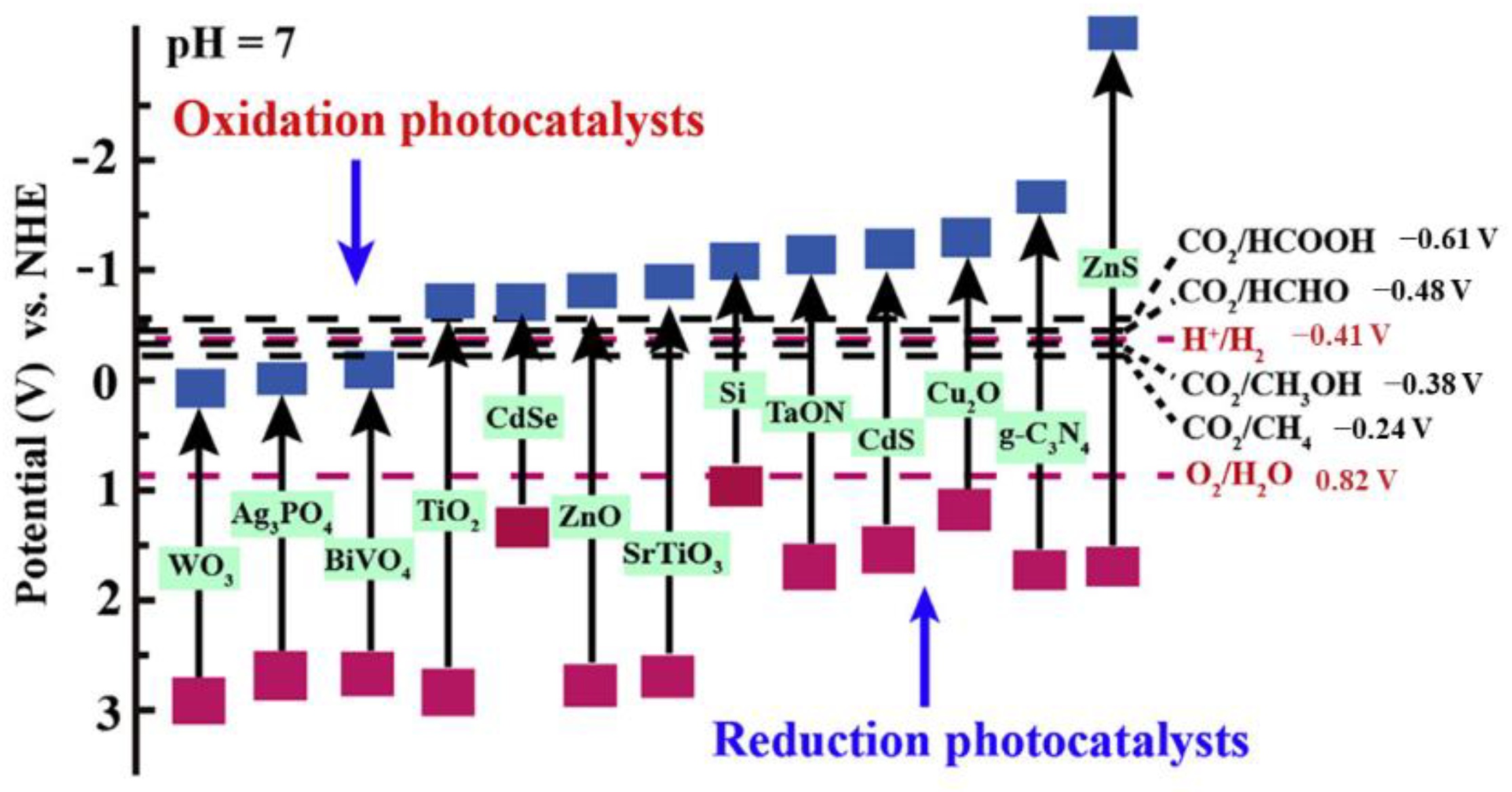
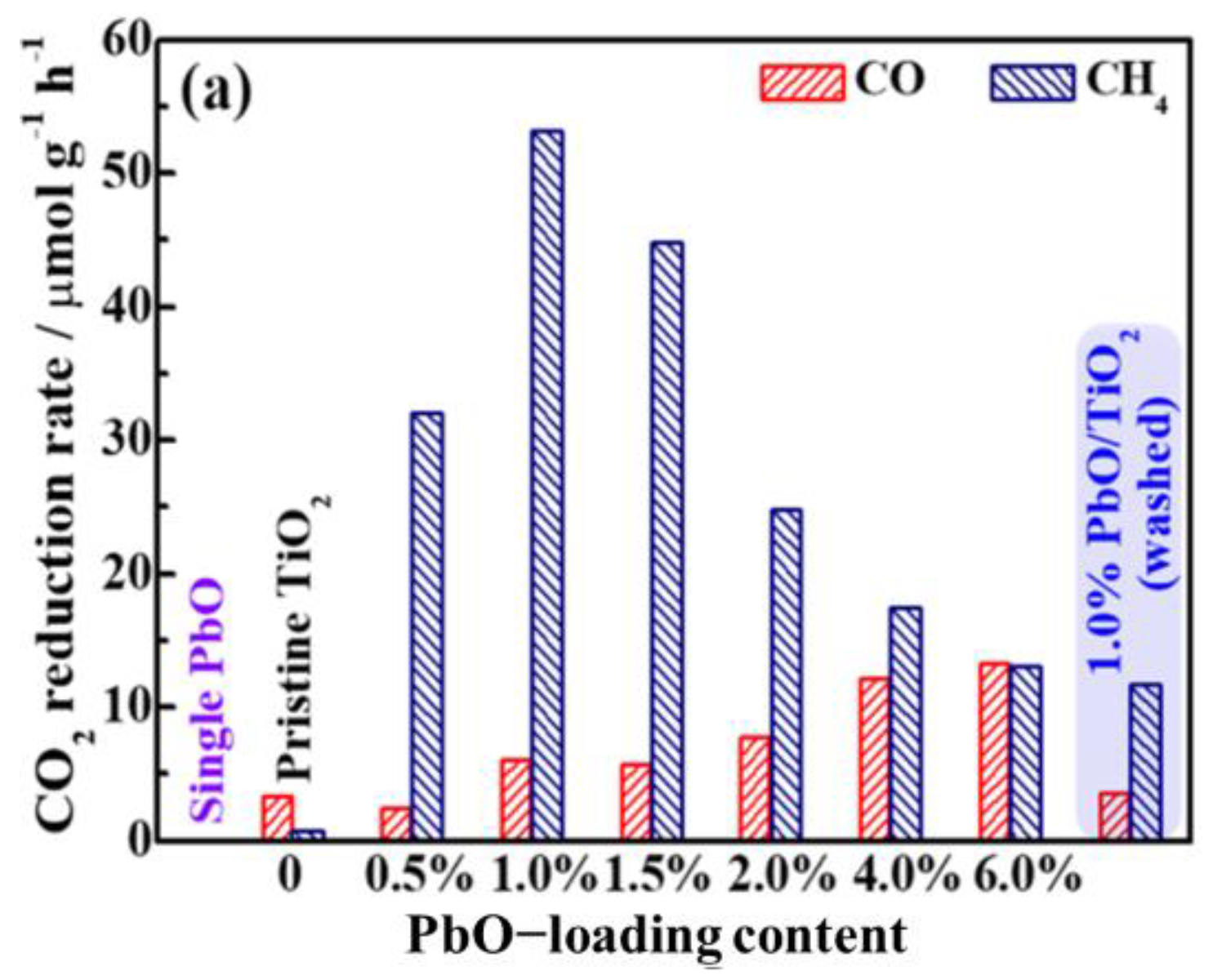
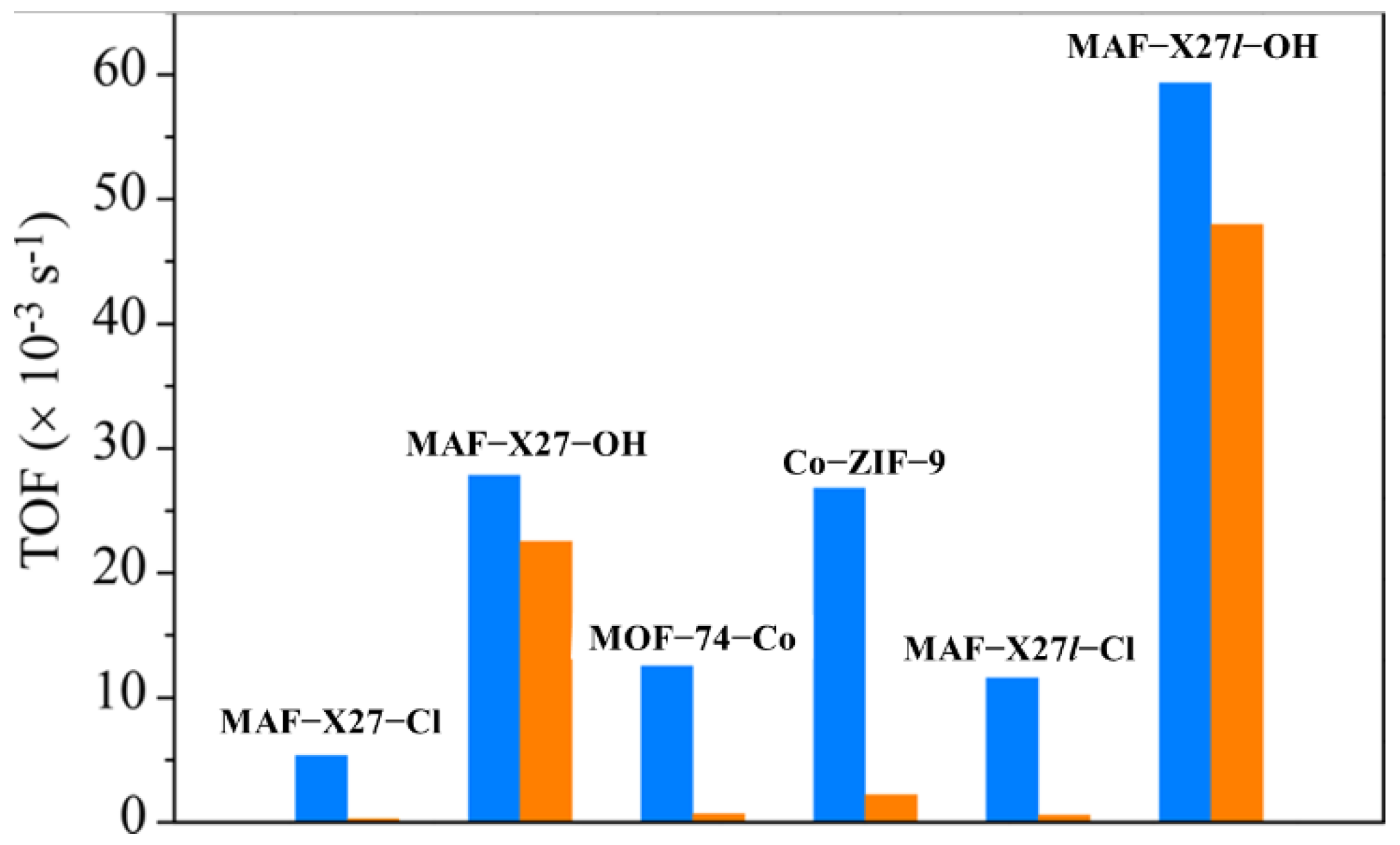
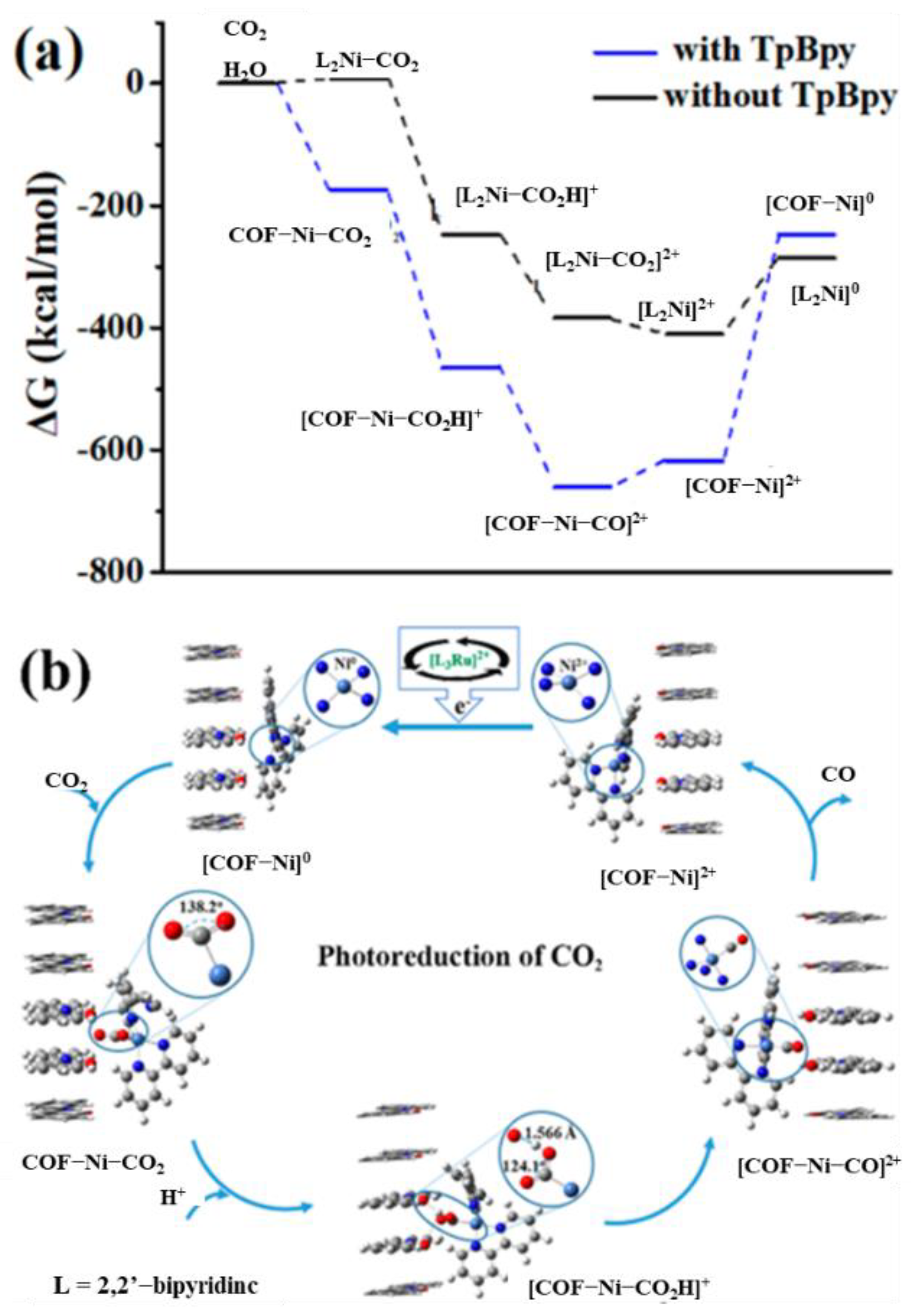
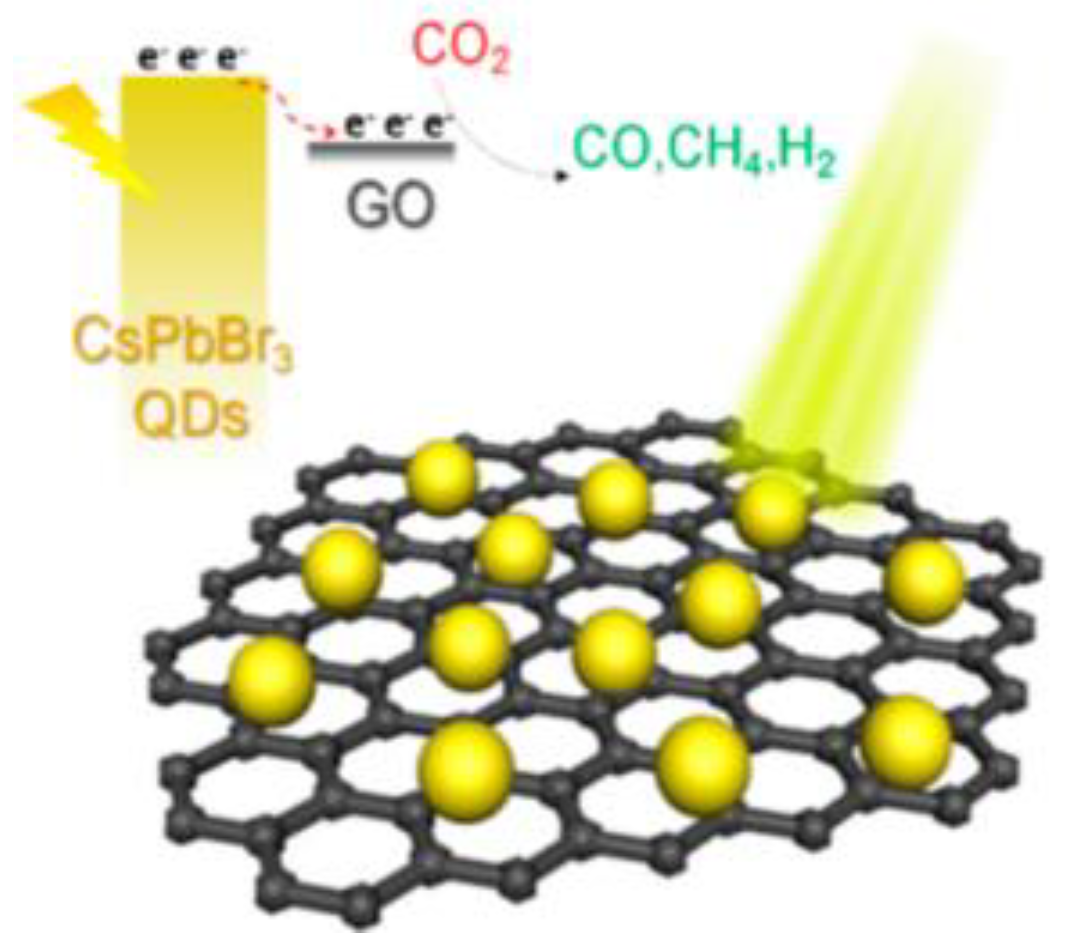
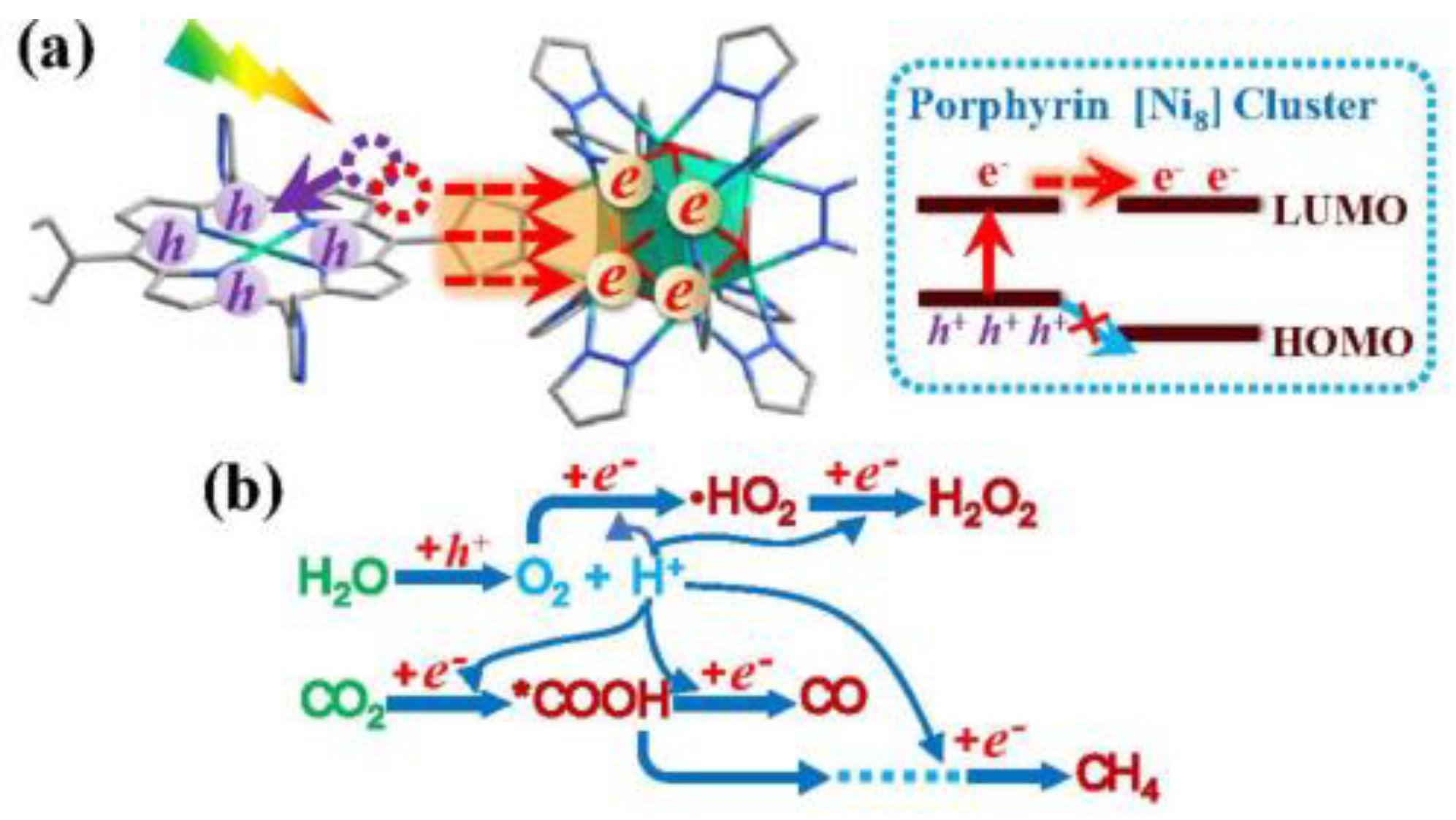
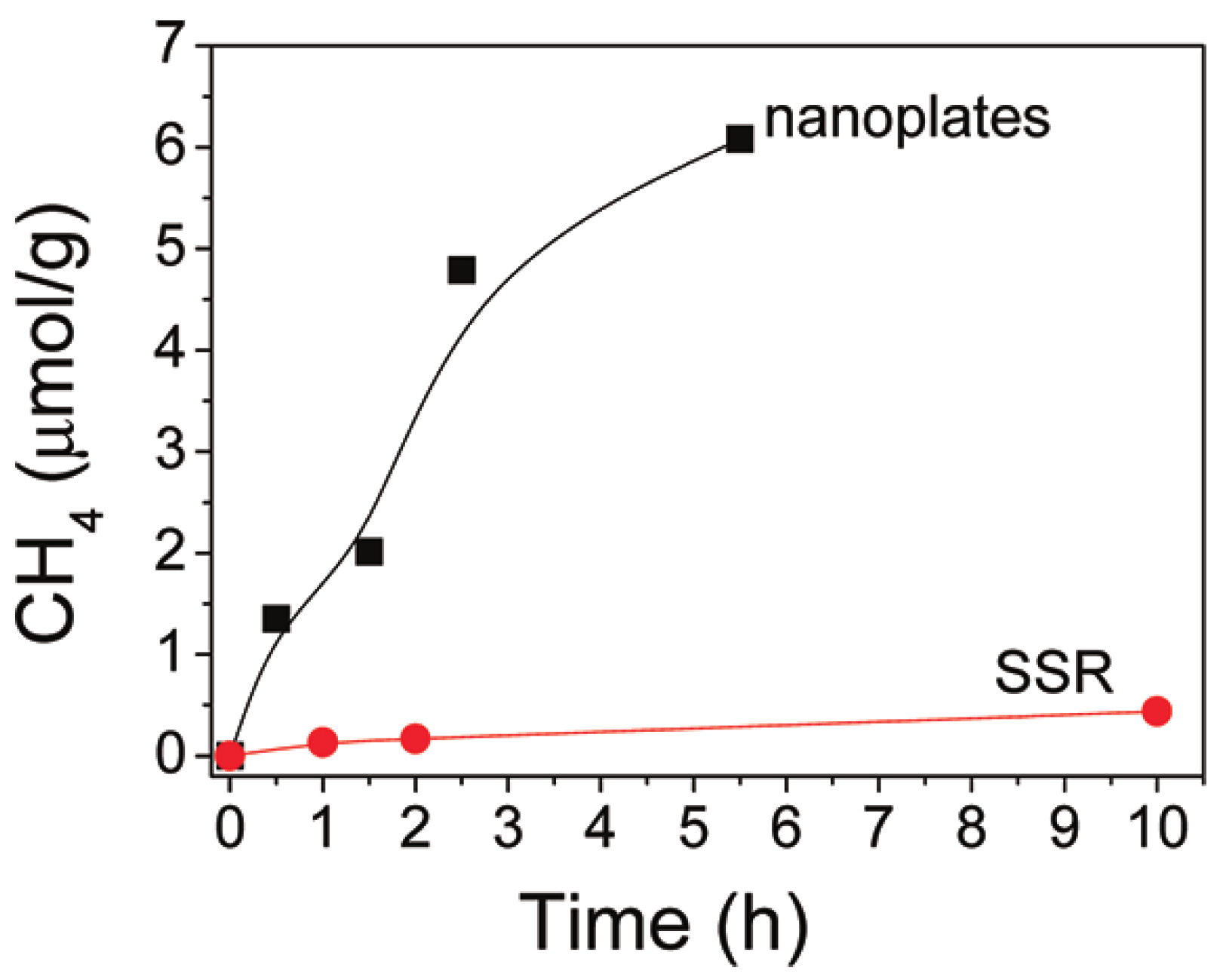
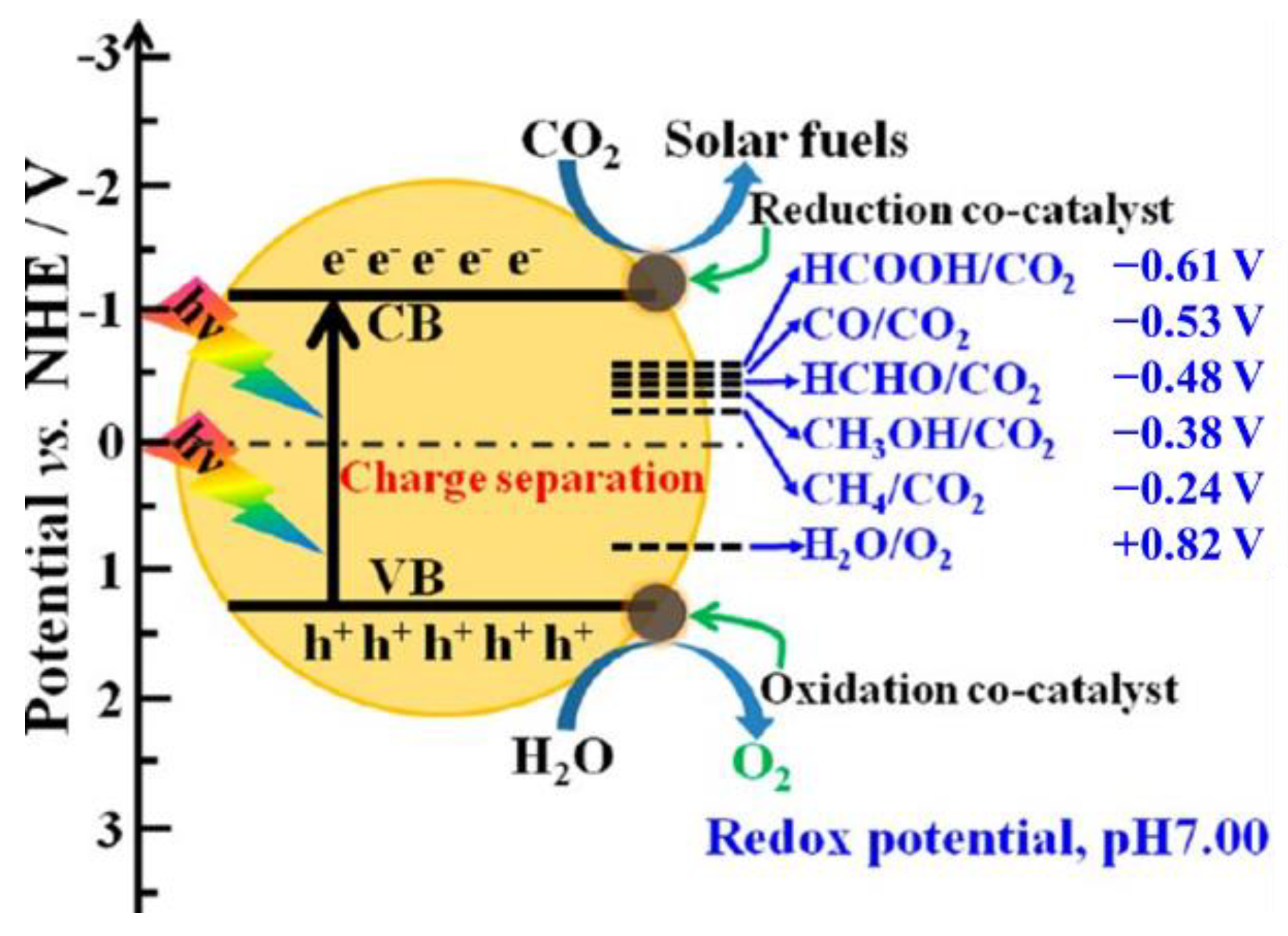
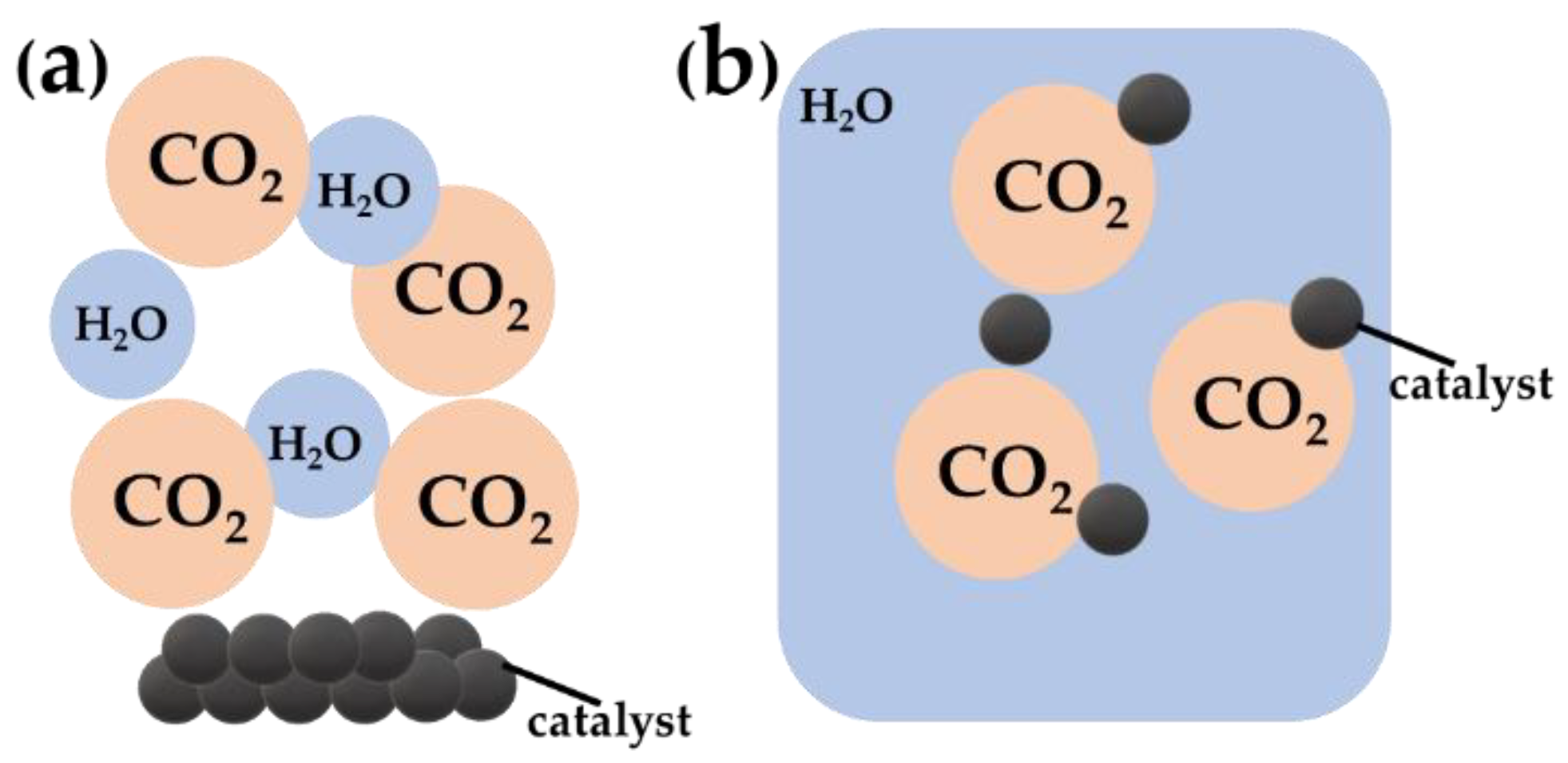
Publisher’s Note: MDPI stays neutral with regard to jurisdictional claims in published maps and institutional affiliations. |
© 2022 by the authors. Licensee MDPI, Basel, Switzerland. This article is an open access article distributed under the terms and conditions of the Creative Commons Attribution (CC BY) license (https://creativecommons.org/licenses/by/4.0/).
Share and Cite
Cui, Y.; Ge, P.; Chen, M.; Xu, L. Research Progress in Semiconductor Materials with Application in the Photocatalytic Reduction of CO2. Catalysts 2022, 12, 372. https://doi.org/10.3390/catal12040372
Cui Y, Ge P, Chen M, Xu L. Research Progress in Semiconductor Materials with Application in the Photocatalytic Reduction of CO2. Catalysts. 2022; 12(4):372. https://doi.org/10.3390/catal12040372
Chicago/Turabian StyleCui, Yan, Pengxiang Ge, Mindong Chen, and Leilei Xu. 2022. "Research Progress in Semiconductor Materials with Application in the Photocatalytic Reduction of CO2" Catalysts 12, no. 4: 372. https://doi.org/10.3390/catal12040372
APA StyleCui, Y., Ge, P., Chen, M., & Xu, L. (2022). Research Progress in Semiconductor Materials with Application in the Photocatalytic Reduction of CO2. Catalysts, 12(4), 372. https://doi.org/10.3390/catal12040372






